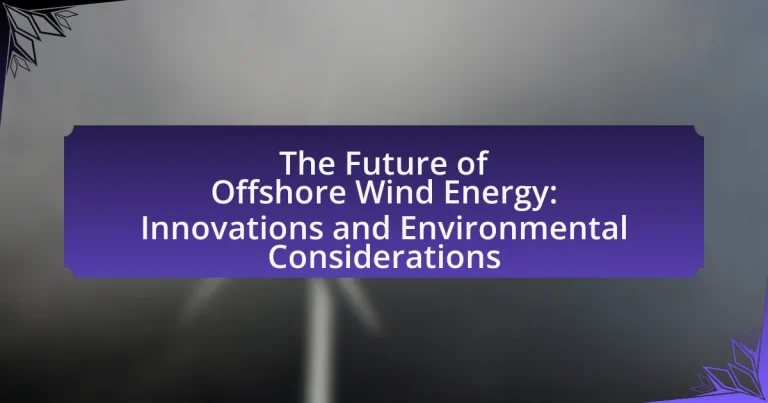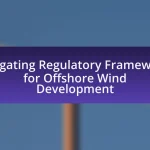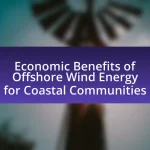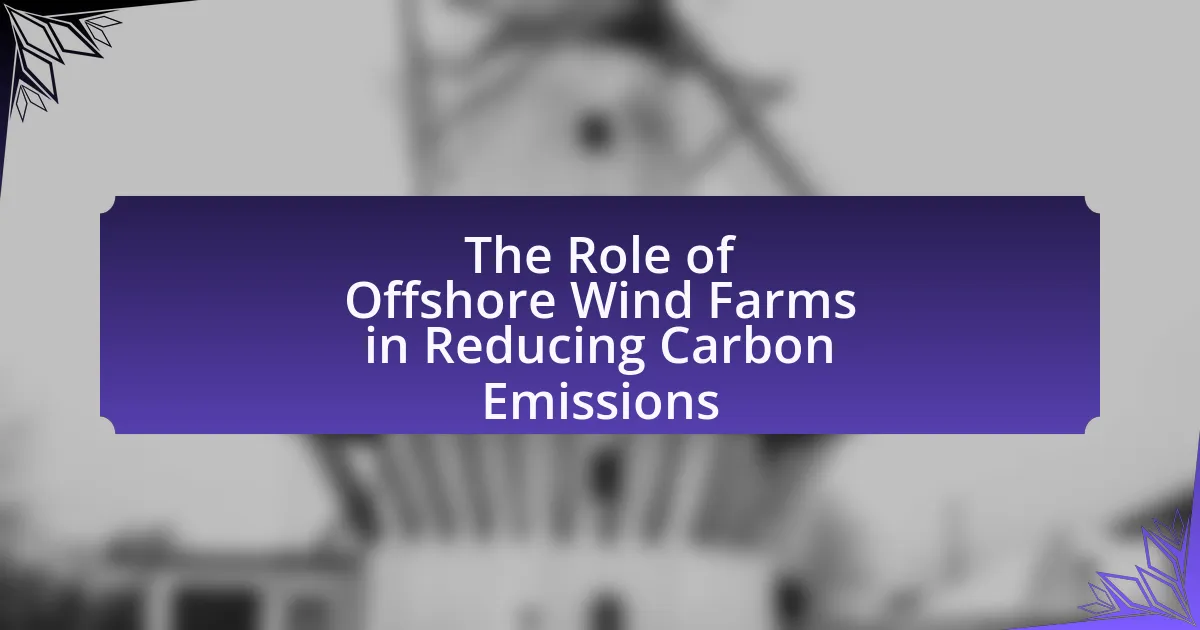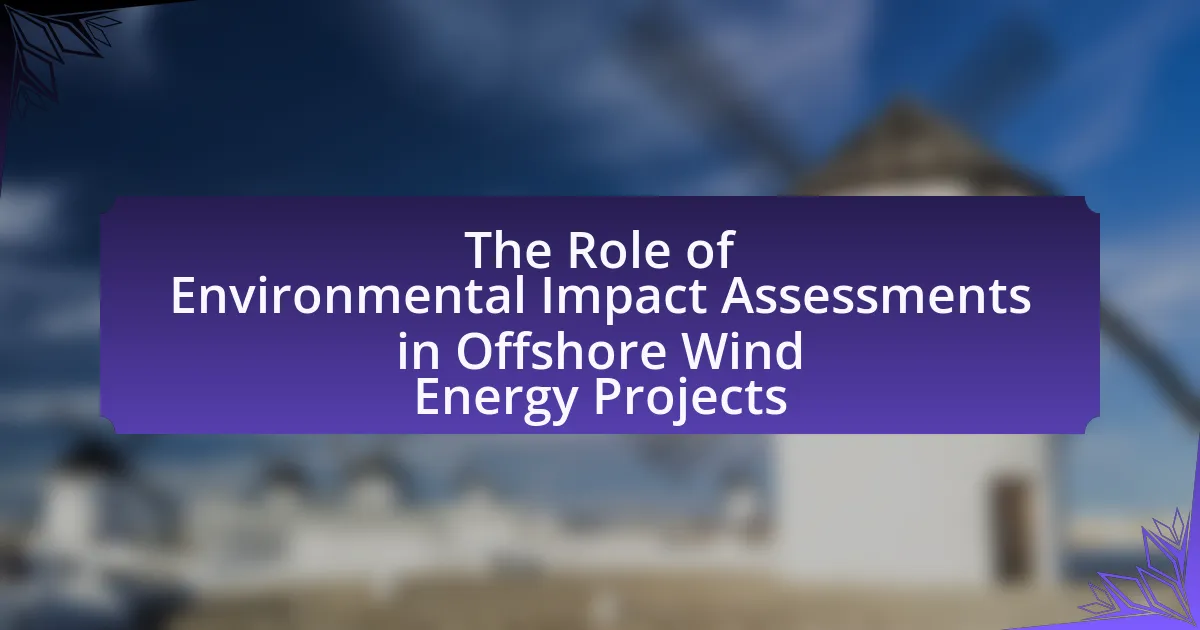Offshore wind energy is the generation of electricity from wind turbines located in bodies of water, leveraging stronger and more consistent wind patterns than onshore installations. This article explores the significance of offshore wind energy in the global energy transition, highlighting its advantages, such as higher energy output and reduced land use conflicts, while also addressing the challenges it faces, including higher costs and environmental impacts. Key innovations shaping the future of offshore wind energy, including larger turbine designs and digital technologies, are discussed alongside the environmental considerations and regulatory frameworks that govern its development. The article emphasizes the importance of balancing energy production with environmental stewardship and outlines best practices for sustainable offshore wind energy development.
What is Offshore Wind Energy and Why is it Important?
Offshore wind energy refers to the generation of electricity from wind turbines located in bodies of water, typically on the continental shelf. This energy source is important because it harnesses strong and consistent wind patterns found offshore, leading to higher energy output compared to onshore wind farms. According to the Global Wind Energy Council, offshore wind capacity has been growing rapidly, with a global installed capacity of over 35 gigawatts by the end of 2020, highlighting its potential to contribute significantly to renewable energy targets and reduce greenhouse gas emissions.
How does Offshore Wind Energy differ from Onshore Wind Energy?
Offshore wind energy differs from onshore wind energy primarily in its location and environmental conditions. Offshore wind farms are situated in bodies of water, typically far from shore, which allows for stronger and more consistent wind speeds compared to onshore sites that are often affected by terrain and obstacles. According to the U.S. Department of Energy, offshore wind resources can be 50% stronger than onshore resources, leading to higher energy generation potential. Additionally, offshore installations face unique challenges such as harsher weather conditions and higher construction and maintenance costs, while onshore wind farms generally benefit from easier access and lower installation costs.
What are the advantages of Offshore Wind Energy over Onshore Wind Energy?
Offshore wind energy has several advantages over onshore wind energy, primarily due to its higher energy generation potential and reduced land use conflicts. Offshore wind farms can harness stronger and more consistent wind speeds, leading to increased energy output; for instance, studies show that offshore wind can produce up to 50% more energy than onshore installations. Additionally, offshore wind farms do not compete for land with agriculture or urban development, minimizing land use conflicts and allowing for larger installations. Furthermore, offshore wind turbines can be built larger and more efficiently, with some models exceeding 10 MW in capacity, compared to typical onshore turbines that are often limited to around 3 MW. These factors contribute to the growing preference for offshore wind energy as a viable and sustainable energy source.
What challenges does Offshore Wind Energy face compared to Onshore Wind Energy?
Offshore wind energy faces higher costs and logistical challenges compared to onshore wind energy. The installation and maintenance of offshore wind farms require specialized vessels and equipment, significantly increasing capital expenditures. For instance, the cost of offshore wind energy projects can be 1.5 to 2 times higher than onshore projects due to these factors. Additionally, offshore wind farms are subject to harsher environmental conditions, such as strong winds and waves, which complicate construction and operation. Furthermore, the connection to the electrical grid is more complex and costly for offshore installations, often requiring underwater cabling and substations. These challenges contribute to the slower development and deployment of offshore wind energy compared to its onshore counterpart.
What role does Offshore Wind Energy play in the global energy transition?
Offshore wind energy plays a crucial role in the global energy transition by providing a significant source of renewable energy that reduces reliance on fossil fuels. As of 2023, offshore wind capacity has reached over 50 gigawatts globally, contributing to the decarbonization of the energy sector and helping countries meet their climate targets. The International Energy Agency projects that offshore wind could supply up to 18% of global electricity by 2040, highlighting its potential to support sustainable energy systems. This transition is further supported by advancements in technology, such as larger turbines and floating wind farms, which enhance energy capture and expand deployment opportunities in deeper waters.
How can Offshore Wind Energy contribute to reducing carbon emissions?
Offshore wind energy significantly contributes to reducing carbon emissions by generating electricity without burning fossil fuels. This renewable energy source harnesses wind power to produce clean energy, which can replace electricity generated from coal, natural gas, and oil, all of which emit high levels of carbon dioxide. According to the International Renewable Energy Agency (IRENA), offshore wind energy has the potential to reduce global carbon emissions by up to 4 gigatons annually by 2030, as it scales up and integrates into energy systems worldwide. This transition to offshore wind energy not only mitigates climate change but also supports energy security and economic growth through job creation in the renewable sector.
What are the economic implications of investing in Offshore Wind Energy?
Investing in offshore wind energy has significant economic implications, including job creation, energy cost reduction, and increased energy independence. The offshore wind sector is projected to create over 200,000 jobs in the United States by 2030, according to the U.S. Department of Energy. Additionally, the levelized cost of energy from offshore wind has decreased by 70% since 2009, making it increasingly competitive with fossil fuels. This reduction in costs not only benefits consumers through lower energy prices but also stimulates local economies through investments in infrastructure and technology. Furthermore, offshore wind energy contributes to energy independence by diversifying the energy supply and reducing reliance on imported fuels, which enhances national security and stabilizes energy prices.
What Innovations are Shaping the Future of Offshore Wind Energy?
Innovations shaping the future of offshore wind energy include larger turbine designs, floating wind farms, and advanced energy storage solutions. Larger turbines, such as those exceeding 12 MW, increase energy capture and efficiency, significantly reducing the cost per megawatt-hour. Floating wind farms enable deployment in deeper waters, where wind resources are stronger and more consistent, expanding the potential for offshore wind energy generation. Additionally, advancements in energy storage technologies, like lithium-ion and flow batteries, enhance grid stability by storing excess energy generated during peak production times. These innovations collectively contribute to the growth and sustainability of offshore wind energy, making it a vital component of the renewable energy landscape.
How are technological advancements improving Offshore Wind Turbines?
Technological advancements are improving offshore wind turbines by enhancing their efficiency, reliability, and cost-effectiveness. Innovations such as larger turbine sizes, advanced materials, and improved design software allow for greater energy capture and reduced maintenance needs. For instance, the deployment of turbines with rotor diameters exceeding 200 meters has been shown to increase energy production by up to 30% compared to smaller models. Additionally, the use of predictive maintenance technologies, powered by artificial intelligence, enables operators to anticipate failures and minimize downtime, further optimizing performance. These advancements collectively contribute to making offshore wind energy a more viable and sustainable option in the renewable energy landscape.
What are the latest designs in Offshore Wind Turbines?
The latest designs in offshore wind turbines include larger rotor diameters, floating turbine technology, and advanced materials for enhanced durability. For instance, Siemens Gamesa has developed the SG 14-222 DD turbine, featuring a rotor diameter of 222 meters, which allows for increased energy capture and efficiency. Additionally, floating wind turbine designs, such as those by Equinor’s Hywind project, enable deployment in deeper waters, expanding the potential for offshore wind energy generation. These innovations are supported by ongoing research and development efforts aimed at improving performance and reducing costs in the offshore wind sector.
How do these innovations enhance energy efficiency and output?
Innovations in offshore wind energy enhance energy efficiency and output by utilizing advanced turbine designs, improved materials, and optimized energy management systems. These innovations, such as larger rotor diameters and higher hub heights, increase energy capture from wind, resulting in higher overall energy production. For instance, the deployment of floating wind turbines allows for installation in deeper waters where wind speeds are typically higher, thus maximizing energy generation potential. Additionally, the integration of predictive maintenance technologies reduces downtime and operational costs, further improving efficiency. According to the International Energy Agency, advancements in turbine technology have led to a 50% increase in energy output per installed capacity over the past decade, demonstrating the significant impact of these innovations on energy efficiency and output in offshore wind energy.
What role does digital technology play in Offshore Wind Energy?
Digital technology plays a crucial role in offshore wind energy by enhancing operational efficiency, improving predictive maintenance, and optimizing energy production. Advanced data analytics and IoT sensors enable real-time monitoring of turbine performance, which helps in identifying potential issues before they lead to failures. For instance, the integration of digital twins allows for simulations that predict how turbines will perform under various conditions, leading to better design and operational strategies. Furthermore, the use of machine learning algorithms can analyze vast amounts of operational data to optimize energy output, resulting in increased reliability and reduced costs. According to a report by the International Renewable Energy Agency, digital technologies can reduce operational costs by up to 20% in offshore wind farms, demonstrating their significant impact on the industry.
How can data analytics optimize the performance of Offshore Wind Farms?
Data analytics can optimize the performance of offshore wind farms by enabling predictive maintenance, enhancing energy output forecasting, and improving operational efficiency. Predictive maintenance utilizes data from sensors to anticipate equipment failures, reducing downtime and maintenance costs; for instance, a study by the National Renewable Energy Laboratory found that predictive maintenance can decrease maintenance costs by up to 30%. Enhanced energy output forecasting leverages historical weather and performance data to improve the accuracy of energy production predictions, which can lead to better grid management and energy trading strategies. Additionally, data analytics can identify patterns in operational performance, allowing for real-time adjustments that maximize energy generation and reduce operational inefficiencies.
What are the benefits of using AI and machine learning in Offshore Wind Energy?
The benefits of using AI and machine learning in offshore wind energy include enhanced predictive maintenance, optimized energy production, and improved operational efficiency. AI algorithms analyze vast amounts of data from wind turbines to predict failures before they occur, reducing downtime and maintenance costs. Machine learning models optimize turbine performance by adjusting settings based on real-time environmental conditions, which can increase energy output by up to 10%. Additionally, AI-driven analytics improve site selection and design by evaluating wind patterns and environmental impacts, leading to more effective and sustainable offshore wind projects.
What Environmental Considerations are Associated with Offshore Wind Energy?
Environmental considerations associated with offshore wind energy include impacts on marine ecosystems, bird and bat mortality, and potential effects on local fisheries. The construction and operation of offshore wind farms can disrupt habitats, leading to changes in species distribution and behavior. Studies indicate that wind turbines can pose collision risks for birds and bats, with estimates suggesting that thousands of birds may be affected annually. Additionally, the presence of wind farms can alter fish populations and their habitats, potentially affecting commercial fishing activities. Research from the National Renewable Energy Laboratory highlights the importance of environmental assessments to mitigate these impacts and ensure sustainable development of offshore wind energy.
How does Offshore Wind Energy impact marine ecosystems?
Offshore wind energy impacts marine ecosystems primarily through habitat alteration and potential disruption of marine life. The construction and operation of wind farms can lead to changes in seabed habitats, affecting species that rely on specific substrates. For instance, the installation of turbines can create artificial reefs, which may benefit some species while displacing others. Additionally, noise generated during construction can disturb marine mammals and fish, potentially affecting their behavior and migration patterns. Research indicates that while some species may thrive in altered habitats, others may experience population declines due to these changes, highlighting the complex interactions between offshore wind energy infrastructure and marine ecosystems.
What measures can be taken to mitigate the environmental impact?
To mitigate the environmental impact of offshore wind energy, developers can implement measures such as careful site selection, use of environmentally friendly materials, and ongoing environmental monitoring. Careful site selection minimizes disruption to sensitive marine ecosystems, as studies show that avoiding areas with high biodiversity can significantly reduce ecological harm. Utilizing environmentally friendly materials, such as low-impact foundations and biodegradable lubricants, further lessens the ecological footprint. Additionally, ongoing environmental monitoring during and after construction allows for the assessment of impacts on marine life, enabling timely adjustments to operations to protect local ecosystems.
How do Offshore Wind Farms affect local wildlife?
Offshore wind farms can significantly impact local wildlife, particularly marine species and birds. The construction and operation of these farms can lead to habitat disruption, noise pollution, and potential collisions with turbine structures. Research indicates that marine mammals, such as dolphins and whales, may be affected by underwater noise generated during construction, which can interfere with their communication and navigation. Additionally, studies have shown that birds may experience increased mortality rates due to collisions with turbine blades, especially in areas where migratory routes overlap with wind farm locations. For instance, a study published in the journal “Ecology and Evolution” highlighted that certain bird species, like seabirds, are particularly vulnerable to these impacts, emphasizing the need for careful site selection and monitoring to mitigate adverse effects on local wildlife.
What are the regulatory frameworks governing Offshore Wind Energy?
The regulatory frameworks governing Offshore Wind Energy primarily include national legislation, international treaties, and regional agreements that establish guidelines for development, environmental protection, and energy production. In the United States, the Bureau of Ocean Energy Management (BOEM) oversees leasing and permitting processes, while the National Environmental Policy Act (NEPA) mandates environmental assessments. In Europe, the Renewable Energy Directive and the Marine Spatial Planning Directive guide member states in promoting renewable energy while ensuring environmental sustainability. These frameworks are designed to balance the growth of offshore wind energy with ecological considerations, ensuring compliance with safety and environmental standards.
How do regulations ensure environmental protection in Offshore Wind projects?
Regulations ensure environmental protection in offshore wind projects by establishing strict guidelines and standards that developers must follow to minimize ecological impact. These regulations often include environmental assessments, which evaluate potential effects on marine life, habitats, and local ecosystems before project approval. For instance, the National Environmental Policy Act (NEPA) in the United States mandates comprehensive environmental reviews for offshore wind projects, ensuring that potential risks are identified and mitigated. Additionally, regulations may require ongoing monitoring and reporting to ensure compliance with environmental standards throughout the project’s lifecycle, thereby safeguarding marine environments and promoting sustainable development.
What are the challenges in navigating these regulatory frameworks?
Navigating regulatory frameworks for offshore wind energy presents several challenges, including complexity, variability, and compliance costs. The complexity arises from the need to understand and integrate multiple regulations at local, national, and international levels, which can differ significantly. Variability in regulations across jurisdictions can lead to confusion and delays in project development. Compliance costs can be substantial, as developers must invest in legal expertise and resources to meet regulatory requirements, which can impact project feasibility and timelines. These challenges are critical as they can hinder the growth and implementation of offshore wind energy projects, ultimately affecting the transition to renewable energy sources.
What are the best practices for sustainable Offshore Wind Energy development?
The best practices for sustainable offshore wind energy development include thorough environmental impact assessments, stakeholder engagement, and the use of advanced technology for site selection and turbine design. Conducting comprehensive environmental impact assessments ensures that potential effects on marine ecosystems are identified and mitigated, as evidenced by studies showing reduced biodiversity loss when such assessments are performed. Engaging stakeholders, including local communities and environmental groups, fosters transparency and collaboration, which has been shown to enhance project acceptance and success rates. Additionally, employing advanced technologies, such as Geographic Information Systems (GIS) for site selection and innovative turbine designs that minimize noise and visual impact, contributes to more efficient energy production while reducing ecological footprints. These practices collectively support the long-term viability and acceptance of offshore wind energy projects.
How can developers balance energy production with environmental stewardship?
Developers can balance energy production with environmental stewardship by implementing sustainable practices and technologies in offshore wind energy projects. This includes conducting thorough environmental impact assessments to identify potential effects on marine ecosystems and employing mitigation strategies, such as adjusting turbine placement to minimize disruption to wildlife. Research indicates that integrating advanced monitoring systems can help track environmental changes and inform adaptive management strategies, ensuring that energy production does not compromise ecological integrity. For instance, a study by the National Renewable Energy Laboratory highlights that careful site selection and turbine design can significantly reduce the impact on bird and marine life, demonstrating that it is feasible to achieve both energy goals and environmental protection.
What lessons can be learned from existing Offshore Wind projects?
Existing offshore wind projects demonstrate the importance of robust site assessment and planning to optimize energy production and minimize environmental impact. For instance, the Hornsea One project in the UK, which is the world’s largest offshore wind farm, utilized extensive environmental monitoring to mitigate risks to marine life and ensure compliance with regulations. Additionally, lessons from the Block Island Wind Farm in the US highlight the significance of stakeholder engagement and community support in project development, which can lead to smoother permitting processes and enhanced public acceptance. Furthermore, operational data from projects like the Gemini Wind Park in the Netherlands reveal that advancements in turbine technology can significantly increase efficiency and reduce costs, emphasizing the need for continuous innovation in design and engineering practices.
